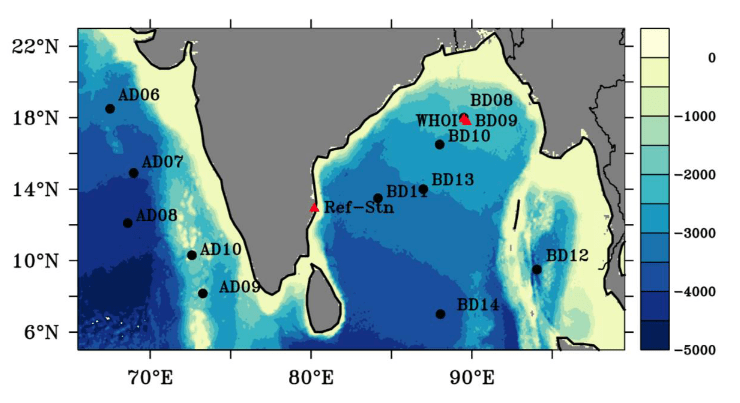A paper by Ms Jossia Joseph (Scientist-E at National Institute of Ocean Technology) has just been published in Journal of Atmospheric and Oceanic Technology titled “Longwave Radiation Corrections for the OMNI Buoy Network” with Prof Amit Tandon as one of the co-authors. This paper describes corrections performed in the OMNI Buoy network when there was an over-estimation of Longwave Radiation in OMNI Buoy network found when compared with a nearby mooring from Woods Hole Oceanographic Institute (WHOI) during 2015 ASIRI experiment. The paper can be found here.
Congratulations Jossia and Prof Tandon!

OMNI Buoy Network (figure-1 of paper)

A major result showing corrections in Longwave radiation calculations (figure-10 of the paper).
The abstract of this study appears below:
The inception of a moored buoy network in the northern Indian Ocean in 1997 paved the way for systematic collection of longterm time series observations of meteorological and oceanographic parameters. This buoy network was revamped in 2011 with OMNI (Ocean Moored buoy Network for north Indian Ocean) buoys fitted with additional sensors to better quantify the air-sea fluxes. An inter-comparison of OMNI buoy measurements with the nearby WHOI mooring during the year 2015 revealed an overestimation of downwelling longwave radiation (LWR↓). Analysis of the OMNI and WHOI radiation sensors at a test station at NIOT during 2019 revealed that the accurate and stable amplification of the thermopile voltage records along with the customized data logger in the WHOI system results in better estimations of LWR↓. The offset in NIOT measured LWR↓ is estimated firstly by segregating the LWR↓ during clear sky conditions identified using the downwelling shortwave radiation measurements from the same test station, and secondly, finding the offset by taking the difference with expected theoretical clear sky LWR↓. The corrected LWR↓ exhibited good agreement with that of collocated WHOI measurements, with a correlation of 0.93. This method is applied to the OMNI field measurements and again compared with the nearby WHOI mooring measurements, exhibiting a better correlation of 0.95. This work has led to the revamping of radiation measurements in OMNI buoys and provides a reliable method to correct past measurements and improve estimation of air-sea fluxes in the Indian Ocean.
Recent Comments